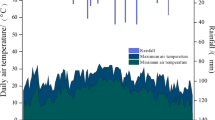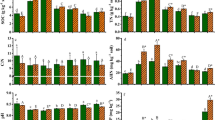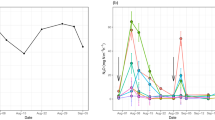Abstract
This long-term study used a lysimeter platform to monitor the NH3 and N2O emissions of summer maize resulting from various fertilization treatments in the Huanghuaihai area, with the goal to assess the efficiency of fertilization measures aimed at reducing NH3 and N2O losses during the production of summer maize; the results provide a theoretical basis for synergistically improving maize yield and fertilizer utilization efficiency. A 2-year field trial was conducted. The trial included a no-N-fertilizer treatment as a control to study the following three fertilizer treatments: the exclusive application of urea, the exclusive application of cattle manure, and the combined application of organic and inorganic fertilizers. The results show that during the two maize growth seasons included in the trial, the average N2O losses associated with exclusively applying urea, exclusively applying cattle manure, and the combined application of organic and inorganic fertilizers were 273%, 542%, and 376% higher than those associated with the control treatment, respectively. During the same period, the average accumulative ammonia volatilization losses were 311%, 542% and 376% higher than those for the control treatment, respectively. The average nitrogen accumulation resulting from the combined application of organic and inorganic fertilizers was 82% higher than that for the control treatment, 12% higher than that for the exclusive application of cattle manure, and 6% higher than that for the exclusive application of urea. The average grain yield for the combined application of organic and inorganic fertilizers, the exclusive application of urea and the exclusive application of cattle manure were 76%, 68% and 61% higher than that for the control treatment, respectively. Overall, the combined application of organic and inorganic fertilizers showed a lower ammonia volatilization loss than the exclusive application of urea, which resulted in a higher ammonium nitrogen and nitrate nitrogen content in the soil, an increased nitrogen uptake, an increased dry matter accumulation of maize, and a high grain yield and nitrogen recovery efficiency.



Similar content being viewed by others
References
Bin H, Zhang DW, Wang XM, Tian X, Li HL, Li JB (2007) Where is the promotion of organic fertilizer? Chin Agric Resour 8:36–38 (in Chinese)
Chauhan SS, Bhatnagar RK (2014) Influence of long term use of organic and inorganic manures on soil fertility and sustainable productivity of wheat in vertisols of madhya pradesh. Asian J Soil Sci 9:113–116
China Soil Science Association Agricultural Chemistry Committee (1983) Soil agricultural chemical routine analysis method. Science Press, Beijing, pp 67–68 (in Chinese)
Cui P, Fan F, Chang Y, Song A, Huang P, Tang Y (2016) Long-term organic and inorganic fertilization alters temperature sensitivity of potential N2O emissions and associated microbes. Soil Biol Biochem 93:131–141
Diez JA, Roman R, Caballero R, Caballero A (1997) Nitrate leaching from soils under a maize-wheat-maize sequence, two irrigation schedules and three types of fertilizers. Agric Ecosyst Environ 65:189–199
Ding J, Jiang X, Ma M, Zhou B, Guan D, Zhao B (2016) Effect of 35 years inorganic fertilizer and manure amendment on structure of bacterial and archaeal communities in black soil of northeast china. Appl Soil Ecol 105:187–195
Dong W, Hu C, Zhang Y, Junfang C (2009) Ammonia volatilization from urea incorporation with wheat and maize straw on a loamy soil in China. In: Proceedings of the International Plant Nutrition Colloquium XVI
Erisman JW, Sutton MA, Galloway J, Klimont Z, Winiwarter W (2008) How a century of ammonia synthesis changed the world. Nat Geosci 1:636–639
Gao MF, Qiu JJ, Li CS (2012) Modelling nitrogen pollution from livestock breeding using manure-DNDC model. Trans Chin Soc Agric Eng (Trans CSAE) 28:183–189 (in Chinese)
Gu L, Liu P, Shao L, Wang J, Dong S, Zhao B (2014) A lysimeters study of chinese wheat and maize varieties: I. The lysimeters-rain shelter facility and the growth and water use of wheat. Soil Tillage Res 144:133–140
Gu LM, Liu TN, Wang JF, Liu P, Dong ST, Zhao BQ, So HB, Zhang JW, Zhao B, Li J (2016) Lysimeter study of nitrogen losses and nitrogen use efficiency of Northern Chinese wheat. Field Crops Res 188:82–95
Han BW, Wang JQ, Li CJ, Liu SP (2011) Effects of nitrogen application rate and tillage methods on spring maize yield, nitrogen fertilizer utilization efficiency and economic benefits. Chin Soil Fertil 2:28–34 (in Chinese)
Han K, Zhou CJ, Wang LQ (2014) Reducing ammonia volatilization from maize fields with separation of nitrogen fertilizer and water in an alternating furrow irrigation system. J Integr Agric 13:1099–1112
Harrison R, Webb J (2001) A review of the effect of N fertilizer type on gaseous emissions. Adv Agron 73:65–108
Huang Y, Tang Y (2010) An estimate of greenhouse gas (N2O and CO2) mitigation potential under various scenarios of nitrogen use efficiency in Chinese croplands. Glob Change Biol 16:2958–2970
Hutchinson GL, Livingston GP (1993) Use of chamber systems to measure trace gas fluxes. In: Harper LA, Mosier AR, Duxbury JM, Rolston DE (eds) Agricultural ecosystem effects on trace gases and global climate change. ASA Special Publication, Madison, pp 63–78
Jalilian J, Sam MS, Saberali SF, Sadatasilan K (2012) Effects of the combination of beneficial microbes and nitrogen on sunflower seed yields and seed quality traits under different irrigation regimes. Field Crops Res 127:26–34
Jia XC, Liu P, Lynch JP (2018) Greater lateral root branching density in maize improves phosphorus acquisition from low phosphorus soil. J Exp Bot 69:4961–4970
Ju XT, Kou CL, Christie P (2007) Current status of soil environment from excessive application of fertilizers and manures to low contrasting in tensive cropping systems on the North China. Plant Environ Pollut 145:497–507
Li B, Bi Z, Xiong Z (2016) Dynamic responses of nitrous oxide emission and nitrogen use efficiency to nitrogen and biochar amendment in an intensified vegetable field in southeastern China. GCB Bioenergy 9:400–413
Liu M, Hu F, Chen X, Huang Q, Jiao J, Zhang B, Li H (2009) Organic amendments with reduced chemical fertilizer promote soil microbial development and nutrient availability in a subtropical paddy field: the influence of quantity, type and application time of organic amendments. Appl Soil Ecol 42:166–175
Liu HM, Pang FJ, Lan X, Yang DL (2012) Effects of nitrogen fertilizer rate and combined application of organic manure and chemical fertilizer on soil ammonia volatilization in winter-wheat field. J Anhui Agric Sci 40(7119–7122):7249 (in Chinese)
Liu T, Chen X, Hu F, Ran W, Shen Q, Li H (2016) Carbon-rich organic fertilizers to increase soil biodiversity: evidence from a meta-analysis of nematode communities. Agric Ecosyst Environ 232:199–207
Lu RK (2000) Soil agricultural chemical analysis method. China Agricultural Science and Technology Press, Beijing (in Chinese)
Mehnaz KR, Dijkstra FA (2016) Denitrification and associated N2O emissions are limited by phosphorus availability in a grassland soil. Geoderma 284:34–41
NBSPRC (National Bureau of Statistics of the People’s Republic of China) (2017) China statistical yearbook. China Statistics Press, Beijing (in Chinese)
Ni B, Liu M, Lu S, Xie L, Wang Y (2010) Multifunctional slow-release organic–inorganic compound fertilizer. J Agric Food Chem 58:12373–12378
Pan GX, Zhou P, Li ZP, Smith P, Li LQ, Qiu DS (2009) Combined inorganic/organic fertilization enhances N efficiency and increases rice productivity through organic carbon accumulation in a rice paddy from the Tai Lake region, China. Agric Ecosyst Environ 131:274–280
Tian SZ, Ning TY, Chi SJ (2012) Diurnal variations of the greenhouse gases emission and their optimal observation duration under different tillage systems. Acta Ecol Sin 32:879–888
Van der Stelt B, Temminghoff EJ, Van Vliet PC, Van Riemsdijk WH (2007) Volatilization of ammonia from manure as affected by manure additives, temperature and mixing. Bioresour Technol 98:3449–3455
Wang ZH, Liu XJ, Ju XT, Zhang FS, Malhi SS (2004) Ammonia volatilization loss from surface-broadcast urea: comparison of vented-and closed-chamber methods and loss in winter wheat-summer maize rotation in North China Plain. Commun Soil Sci Plant Anal 35:2917–2939
Wen Z, Shen J, Blackwell M, Haigang LI, Zhao B, Yuan H (2016) Combined applications of nitrogen and phosphorus fertilizers with manure increase maize yield and nutrient uptake via stimulating root growth in a long-term experiment. Pedosphere 26:62–73
Wu D, Senbayram M, Well R, Brüggemann N, Pfeiffer B, Loick N (2017) Nitrification inhibitors mitigate N2O emissions more effectively under straw-induced conditions favoring denitrification. Soil Biol Biochem 104:197–207
Xu J, Peng S, Yang S, Wang W (2012) Ammonia volatilization losses from a rice paddy with different irrigation and nitrogen managements. Agric Water Manag 104:184–192
Xu S, Li B, Xia Y (2016) Controlling light quality and intensity can reduce N2O and CO2 emissions of mature aging rice. Greenh Gases Sci Technol 6:308–318
Zaman M, Saggar S, Blennerhassett JD (2009) Effect of urease and nitrification inhibitors on N transformation, gaseous emissions of ammonia and nitrous oxide, pasture yield and N uptake in grazed pasture system. Soil Biol Biochem 41:1270–1280
Zhao J, Ni T, Li J, Lu Q, Fang Z, Huang Q (2016) Effects of organic–inorganic compound fertilizer with reduced chemical fertilizer application on crop yields, soil biological activity and bacterial community structure in a rice–wheat cropping system. Appl Soil Ecol 99:1–12
Zhu S, Vivanco JM, Manter DK (2016) Nitrogen fertilizer rate affects root exudation, the rhizosphere microbiome and nitrogen-use-efficiency of maize. Appl Soil Ecol 107:324–333
Acknowledgments
This work was supported by grants from the National Key Research and Development Program of China (2016YFD0300106), the National Natural Science Foundation of China (31771713; 31371576), and the Shandong Modern Agricultural Technology and Industry System (SDAIT-02-08).
Author information
Authors and Affiliations
Corresponding author
Additional information
Publisher's Note
Springer Nature remains neutral with regard to jurisdictional claims in published maps and institutional affiliations.
Electronic supplementary material
Below is the link to the electronic supplementary material.
Rights and permissions
About this article
Cite this article
Yang, Q., Liu, P., Dong, S. et al. Combined application of organic and inorganic fertilizers mitigates ammonia and nitrous oxide emissions in a maize field. Nutr Cycl Agroecosyst 117, 13–27 (2020). https://doi.org/10.1007/s10705-020-10060-2
Received:
Accepted:
Published:
Issue Date:
DOI: https://doi.org/10.1007/s10705-020-10060-2




